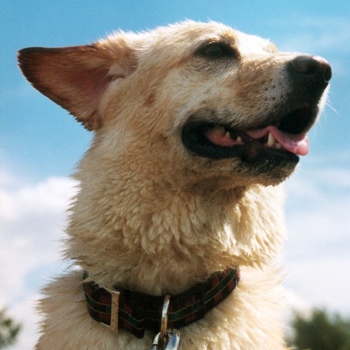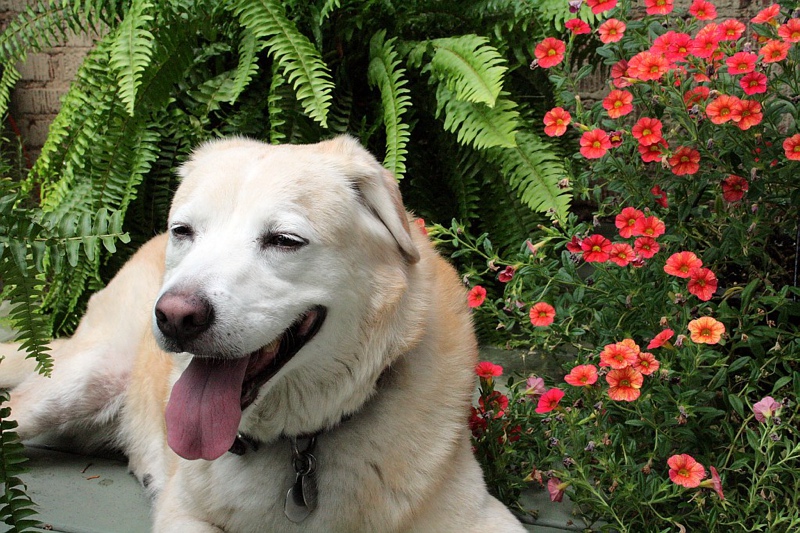Labrakita

A handsome and noble looking dog, the Labrakita is a stocky and well-muscled hybrid breed that has a lot to offer. The parent breeds, the Labrador Retriever and the Akita Inu, both have strong bodies and minds and are well-known for their protective instincts and the devotion they have for their family. Their naturally protective nature means that they require an experienced owner and an abundance of training.
With large skulls and sturdy, imposing bodies the Labrakita is a formidable crossbreed that is well aware of its power. They have a dense coat that offers them good protection from the cold in the winter months. While many individuals are brown and black, they can also have red, white or cream fur and many will have two coat colours, as well as some white patches.
About & History
The Labrakita was likely bred as a guard dog a couple of decades ago but there are no records of the very first Labrakita so we are unsure as to when and where they were initially developed. However, we know plenty about each parent breed so can take a closer look at them to better understand the Labrakita and its history.
The Labrador Retriever
The Labrador Retriever is a gun dog that frequently tops the ‘Most Popular Dog Breeds’ lists around the world. While they are still used as hunting dogs by some, most are kept as companion animals thanks to their friendly temperaments and tolerance of young children. Labradors have a reputation for being ‘vacuum cleaners’ and recent studies have proven that they have genes that make them more food-driven than other breeds. This trait means that they are highly trainable and many will be kept as guide dogs and sniffer dogs thanks to their biddable personalities.
The first Labradors were bred in Newfoundland (an easterly Canadian province) and were not brought to England until the start of the 19th century. Interestingly, all of the first Labradors were black and it was only in later years that the yellow and chocolate colours were allowed within the breed standard.
The Akita Inu
Akita Inus are headstrong dogs who are independent and have their own mind. They are extremely loyal towards their family and can be wary of anyone outside their inner circle. For many owners, their confident personality alongside their guarding abilities are their most attractive feature. Originally from Japan, they have existed there for many centuries and were kept pure thanks to the lack of cross-breeding with others.
They were kept as hunters and would fearlessly pursue a range of intimidating prey,such as black bears and wild boar with no hesitation. As is true for many breeds, the Akita almost became extinct during the Second World War when rations were low and people turned to their dogs as a food source. Luckily, some breed members were released into the mountains where they were allowed to exist and breed without human interference, ensuring the race lived on.
Appearance

Labrakitas are formidable dogs built with solid muscle. Their impressive head is large and square with a flat forehead, almond-shaped brown eyes and a good-sized muzzle. They have a serious expression, which is accentuated by their piercing eyes. Their ears may flop down to the side of their face as happens with their Labrador parent, or they may inherit the erect, triangular ears of the Akita. They have a thick neck, broad chest and solid limbs. Their tail can curl over their back in the distinctive Spitz-like fashion of the Akita, but more often will only curve slightly over their back end.
A fully-grown Labrakita will weigh between 31kg and 45kg and will grow to around 56cm to 64cm at the withers. Some males who inherit more genes from their Akita parent may be even larger than this. The thick fur of the Labrakita is quite short and straight. Many will have slightly thicker fur around their neck and on their tail. Dogs can be several different colours, including black, brown, red, fawn and cream. Many will have a muzzle that is either lighter or darker than their overall coat colour.
Character & Temperament
Loyal to a fault, the Labrakita will practically dedicate its life to its owners and will protect them in all circumstances without question. While this is a desirable feature to some, others may find it tiresome, especially when their dog is wary of every new guest or finds it difficult to trust people such as the vet or groomer. Owners need to work alongside their Labrakita to ensure they do not become hostile with people outside of the immediate family.
It is possible for a Labrakita to co-exist peacefully with children and other animals but they require extensive socialisation from a young age and would need constant supervision due to their large size and potentially powerful bite.
The Labrakita loves living life to the full and is playful and energetic, enjoying any opportunity to run outside off lead or explore their back garden. They don’t particularly like being left to their own devices for too long and prefer to be outside when they have company (of either the two or four-legged variety!).
Trainability
If there is one area of the Labrakita’s life that must be consistent, it is their training. When training is neglected it is always painfully obvious as the dog is unruly and difficult to handle when out in public. All family members must be on board and should participate in training sessions to avoid any confusion.
While some Labrakitas will willingly take part in every training session (especially when there are treats on offer), others can take a little more persuasion. Owners should be firm but fair and offer lots of encouragement every step of the way.
Health
Certain health issues are more commonly seen in the Labrakita than other breeds so owners should educate themselves on the signs to watch for as many conditions carry a better prognosis if diagnosed and managed early on.
Hip Dysplasia
While the environment can play a role in the development of hip dysplasia, there is a known genetic component, which is why those affected with hip dysplasia should be neutered and should never be bred from. Those affected will start to show signs from a young age and may struggle to keep up with their peers when exercising.
This is a progressive disease, meaning a dog’s mobility worsens as they get older. As there are certain surgeries available to young, developing dogs, it is important to try to diagnose this orthopaedic condition as early on as possible in order for all therapeutic options to be available to an owner.
Bloat
Though bloat seems to be less prevalent than it used to be, it can (and does) continue to kill dogs worldwide. They key thing with bloat is that it can potentially be treated successfully if caught early enough. Symptoms include a non-productive retching, panting and a noticeably ‘full’ and tense abdomen.
A quick X-ray, which is usually done conscious, can confirm the suspected diagnosis. If a twisted stomach is identified, an emergency surgery should be carried out to replace the stomach to its normal position before the blood supply is compromised.
Obesity
Genetics and lifestyle both contribute to obesity and, as many Labrakitas are prone to gaining weight and are food-driven, they are often over-weight. This is a particular issue for those with joint disease such as hip dysplasia and/or arthritis as more pressure is put on their joints and they will inevitably suffer more than their slimmer counterparts. Obesity is not an inevitability and can be avoided with strict portion control, prescription diets and consistent exercise.
Exercise and Activity Levels
A big dog that is prone to obesity, owners need to ensure that their Labrakita is getting enough exercise on a daily basis. As well as having access to a fenced in back garden in which to run around and play, these dogs should get around an hour of exercise each day. This can consist of playing fetch, hiking, swimming, etc. and the more varied the activities the better.
Grooming
As the Labrakita can shed a great deal, they should be groomed on a very regular basis – at least several times a week. During the summer season, many will need two grooming sessions every single day. Bathing is not something that needs to be done often and can be reserved for those times when they have rolled in something unpleasant, such as fox poo!

